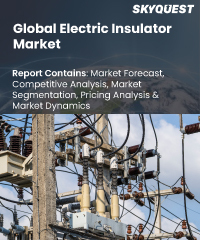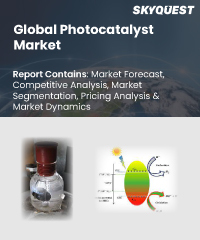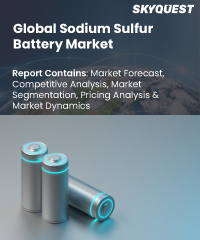USD 12.68 billion

Global Electric Insulator Market Size, Share, Growth Analysis, By Product Type(Ceramic insulators, composite insulators), By Voltage(Low voltage (up to 1 kV), medium voltage (1 kV to 69 kV)), By Application(Power transmission and distribution, railways) - Industry Forecast 2024-2031
Report ID:
SQMIG20D2142 |
Region:
Global |
Published Date: March, 2024
Pages:
202
|
Tables:
91 |
Figures:
76
Global Electric Insulator Market Insights
Global Electric Insulator Market size was valued at USD 12.68 billion in 2022 and is poised to grow from USD 13.39 billion in 2023 to USD 20.71 billion by 2031, growing at a CAGR of 5.60% during the forecast period (2024-2031).
Global Electric Insulator Market is a thriving sector that plays a crucial role in ensuring the safe and reliable transmission and distribution of electricity. The increasing global demand for electricity, driven by population growth, urbanization, and industrialization, creates a need for expanding and upgrading power infrastructure. This, in turn, boosts the demand for electric insulators. Also, the growing focus on renewable energy sources, such as wind and solar power, requires the development of new transmission and distribution systems, further driving the demand for insulators. Additionally, the rising investments in grid modernization, smart grids, and electrification projects worldwide contribute to market growth.
Factors such as economic downturns, budget constraints, and fluctuations in raw material prices can impact market growth. Additionally, the availability of low-cost alternatives and counterfeit products may pose challenges to established market players. Moreover, the complexity and high cost of installing insulators in challenging terrains or remote areas can hinder market expansion in certain regions. Key trends in the electric insulator market include the development of lightweight and compact insulator designs, aimed at improving installation efficiency and reducing maintenance requirements. The integration of advanced materials, such as composite insulators, is gaining traction due to their superior performance, durability, and resistance to environmental factors.
Furthermore, the market is witnessing a shift towards digitalization and IoT-enabled insulator monitoring systems, which enhance the reliability and predictive maintenance capabilities of power networks. Amidst these challenges and trends, several opportunities exist in the electric insulator market. The increasing investments in the expansion and upgrade of power transmission and distribution infrastructure across emerging economies present significant growth prospects. Additionally, the integration of insulators in high-voltage direct current (HVDC) transmission systems for long-distance power transmission offers new avenues for market expansion. Moreover, the focus on renewable energy integration and the electrification of transportation presents opportunities for innovative insulator solutions to meet the evolving needs of the industry.
US Electric Insulator Market is poised to grow at sustainable CAGR for the next forecast year.
Market snapshot - 2024-2031
Global Market Size
Largest Segment
Ceramic Insulators
Fastest Growth
Ceramic Insulators
Growth Rate
5.60% CAGR
To get more reports on the above market click here to Buy The Report
Global Electric Insulator Market Segmental Analysis
Global Electric Insulator Market is segmented on the basis of product type, voltage, application, and region. By product type, the market is segmented into ceramic insulators, composite insulators, and glass insulators. By voltage, the market is segmented into low voltage (up to 1 kV), medium voltage (1 kV to 69 kV), and high voltage (above 69 kV). By application, the market is segmented into power transmission and distribution, railways, electrical equipment, and others. By region, the market is segmented into North America, Europe, Asia Pacific, Middle East and Africa, and Latin America.
Electric Insulator Market Analysis by Product Type
Ceramic insulators segment dominated the market. Ceramic insulators have long been a preferred choice in electrical systems due to their excellent electrical and mechanical properties. These insulators are made from high-quality ceramic materials such as porcelain or alumina, offering superior insulation and high dielectric strength. They are widely used in transmission and distribution lines, substations, and electrical equipment. The dominance of ceramic insulators can be attributed to their long-standing presence in the market, established reliability, and proven performance. They have a strong track record of withstanding extreme weather conditions, pollution, and mechanical stress, making them highly durable and suitable for a wide range of applications. Moreover, ceramic insulators have a high resistance to tracking and provide excellent insulation even in harsh environments, ensuring the safety and reliability of electrical systems.
While ceramic insulators hold the largest market share, the fastest-growing segment in the electric insulator market is composite insulators. Composite insulators are gaining traction due to their numerous advantages over traditional ceramic or glass insulators. These insulators are made from a combination of materials, such as fiberglass reinforced polymer (FRP), silicone rubber, and metal fittings. The rapid growth of composite insulators can be attributed to their lightweight nature, superior mechanical strength, and excellent resistance to pollution and vandalism. Composite insulators offer enhanced performance in terms of electrical insulation, reduced maintenance requirements, and extended service life. They are also less prone to cracking or shattering, ensuring increased safety during installation and operation. Additionally, composite insulators provide excellent resistance to UV radiation and environmental degradation, making them well-suited for outdoor applications.
Electric Insulator Market Analysis by Application
Power transmission and distribution is the largest segment, which plays a critical role in ensuring the efficient and reliable transmission of electricity across vast networks. Electric insulators are essential components in power transmission and distribution systems, as they provide insulation and prevent electrical leaks, thereby maintaining the integrity of the electrical infrastructure. The power transmission and distribution segment is driven by the increasing global demand for electricity, necessitating the expansion and upgrade of existing power grids. Rapid industrialization, urbanization, and population growth contribute to the growing need for a reliable and uninterrupted power supply. As a result, significant investments are being made in the development of new transmission lines, substations, and distribution networks. Furthermore, the shift towards renewable energy sources, such as wind and solar power, necessitates the integration of these intermittent power sources into the existing grid. This integration requires the construction of new transmission lines and substations to transmit renewable energy from generation sites to load centers. Electric insulators are vital in this segment to ensure the safe and efficient transmission of power over long distances.
As for the fastest-growing segment, the railways segment is gaining momentum in the electric insulator market. Railways rely on electric power for various operations, including traction, signaling, and lighting. Electric insulators are crucial in railway applications to insulate and protect power transmission lines, overhead catenary systems, and substations from electrical leaks and interference. The growing focus on the electrification of railway networks, particularly in developing economies, drives the demand for electric insulators in this segment. Electric railways are considered more energy-efficient and environmentally friendly compared to diesel-powered trains. As a result, governments and railway operators are investing in electrification projects to enhance sustainability and reduce carbon emissions. Moreover, the expansion of urban rail transit systems, including metros and light rail systems, further boosts the demand for electric insulators. These systems require a robust infrastructure for power transmission and distribution to ensure uninterrupted operations. Electric insulators play a vital role in maintaining the insulation integrity of the rail electrification systems, ensuring a safe and reliable power supply to trains.
To get detailed analysis on other segments, Request For Free Sample Report
Global Electric Insulator Market Regional Insights
Asia Pacific holds a substantial market share in the global electric insulator market. The region's dominance can be attributed to the increasing investments in power infrastructure, particularly in countries like China and India. China, being the largest electricity consumer globally, has a robust demand for electric insulators to support its expanding power generation and transmission networks. Moreover, India's ambitious plans for renewable energy integration and the development of smart grids contribute to the region's dominance. With a strong presence of key market players and a favorable regulatory environment, Asia Pacific maintains a significant market share in the global electric insulator market.
On the other hand, the Middle East and Africa (MEA) region showcases the fastest-growing potential in the electric insulator market. The MEA region has been experiencing rapid industrialization, urbanization, and infrastructure development, leading to a surge in electricity demand. For instance, countries like Saudi Arabia and the United Arab Emirates are investing heavily in power infrastructure to support their growing economies. These investments drive the demand for electric insulators to ensure safe and efficient electricity transmission and distribution. Additionally, the focus on renewable energy projects in countries like Morocco and South Africa creates further growth opportunities. With a growing emphasis on grid modernization and the need to upgrade aging power infrastructure, the MEA region demonstrates remarkable growth potential in the electric insulator market.
- Largest
- Fastest
To know more about the market opportunities by region and country, click here to
Buy The Complete Report
Global Electric Insulator Market Dynamics
Electric Insulator Market Drivers
Increasing Demand for Electricity
- The rising global population, urbanization, and industrialization have led to a significant increase in the demand for electricity. This drives the need for expanding and upgrading power transmission and distribution infrastructure, which in turn boosts the demand for electric insulators. For example, countries like India and China, with their growing populations and expanding industrial sectors, are investing heavily in power infrastructure development, driving the demand for electric insulators.
Electric Insulator Market Restraints
Budget Constraints
- Economic downturns and budget limitations can impact investment in power infrastructure projects, including the installation of electric insulators. Governments and utilities may prioritize spending on other areas, leading to delays or reduced investments in transmission and distribution systems. This can restrain the growth of the electric insulator market, particularly in regions where budget constraints are prominent.
Request Free Customization of this report to help us to meet your business objectives.
Global Electric Insulator Market Competitive Landscape
The Global Electric Insulator Market features a competitive landscape with several key players vying for market share. Prominent companies in the industry are focused on strategies such as mergers and acquisitions, partnerships, and product innovations to strengthen their position. Some of the prominent players in the market have established strong distribution networks, extensive research and development capabilities, and a wide product portfolio to cater to the diverse needs of customers. They emphasize technological advancements to offer high-performance insulators with enhanced durability, efficiency, and reliability. Additionally, market players are investing in expanding their global presence through collaborations with local manufacturers and entering emerging markets to tap into new growth opportunities. With intense competition driving innovation and quality improvements, the electric insulator market is witnessing a dynamic and competitive environment.
Electric Insulator Market Top Player’s Company Profile
- ABB Ltd. (Switzerland)
- Siemens AG (Germany)
- General Electric Company (US)
- Toshiba Corporation (Japan)
- Schneider Electric SE (France)
- Mitsubishi Electric Corporation (Japan)
- Hitachi, Ltd. (Japan)
- Bharat Heavy Electricals Limited (India)
- Lapp Insulators GmbH (Germany)
- MacLean Power Systems (US)
- NGK Insulators, Ltd. (Japan)
- Crompton Greaves Limited (India)
- Hubbell Incorporated (US)
- Alstom SA (France)
- Southwire Company, LLC (US)
- TE Connectivity Ltd. (Switzerland)
- Victor Insulators, Inc. (US)
- BHEL (India)
- G&W Electric Company (US)
- El Sewedy Electric (Egypt)
Electric Insulator Market Recent Developments
- In February 2022, Recticel Insulation made an exciting announcement, stating that its multilayer thermal insulation products had received certification from the Programme for the Endorsement of Forest Certification (PEFC). This accomplishment positions the company as the first producer of polyisocyanurate (PIR) and polyurethane (PUR) to achieve such recognition. Recticel Insulation's thermal insulation products will now incorporate multilayer paper facings derived from sustainably-managed forests that are PEFC-certified. This initiative showcases the company's commitment to utilizing wood fibers from environmentally responsible sources.
- In April 2021, GE Renewable Energy's Grid Solutions business partnered with Hitachi ABB Power Grids Ltd to revolutionize high voltage equipment. Their collaboration aimed to introduce an alternative gas to sulfur hexafluoride (SF₆), which is known for its high greenhouse gas potential. The companies unveiled their efforts in promoting fluoronitrile-based eco-efficient insulation and switching gas as a substitute for SF₆ gas. This partnership not only demonstrates their dedication to environmental sustainability but also accelerates the adoption of eco-friendly solutions in high-voltage equipment, paving the way for a greener future
Global Electric Insulator Key Market Trends
- Development of Composite Insulators: Composite insulators, made of materials such as silicone rubber and fiberglass, offer advantages over traditional ceramic or glass insulators. They exhibit superior mechanical strength, lightweight design, and better resistance to environmental factors such as pollution and UV radiation. The increasing adoption of composite insulators provides enhanced performance and reliability in various applications, including high-voltage transmission lines and substations.
Global Electric Insulator Market SkyQuest Analysis
SkyQuest’s ABIRAW (Advanced Business Intelligence, Research & Analysis Wing) is our Business Information Product types team that Collects, Collates, Co-relates, and Analyses the Data collected by means of Primary Exploratory Research backed by robust Secondary Desk research.
According to our Global Electric Insulator Market analysis, the increasing demand for electricity, driven by urbanization, industrialization, and power infrastructure expansion, is a significant driver for the market. Additionally, the focus on renewable energy sources and the need for grid modernization and smart grid initiatives further contribute to the market growth. The research also highlights the growing adoption of advanced materials, such as composite insulators, due to their superior performance and durability. Moreover, the integration of digitalization and IoT-enabled monitoring systems in insulators presents opportunities for enhanced operational efficiency and maintenance. While challenges related to economic uncertainties and the availability of low-cost alternatives persist, the market analysts forecast promising growth for the electric insulator market, driven by investments in power infrastructure development and the increasing focus on renewable energy integration.
| Report Metric | Details |
|---|---|
| Market size value in 2023 | USD 12.68 billion |
| Market size value in 2031 | USD 20.71 billion |
| Growth Rate | 5.60% |
| Forecast period | 2024-2031 |
| Forecast Unit (Value) | USD Billion |
| Segments covered |
|
| Regions covered | North America (US, Canada), Europe (Germany, France, United Kingdom, Italy, Spain, Rest of Europe), Asia Pacific (China, India, Japan, Rest of Asia-Pacific), Latin America (Brazil, Rest of Latin America), Middle East & Africa (South Africa, GCC Countries, Rest of MEA) |
| Companies covered |
|
| Customization scope | Free report customization with purchase. Customization includes:-
|
To get a free trial access to our platform which is a one stop solution for all your data requirements for quicker decision making. This platform allows you to compare markets, competitors who are prominent in the market, and mega trends that are influencing the dynamics in the market. Also, get access to detailed SkyQuest exclusive matrix.
Buy The Complete Report to read the analyzed strategies adopted by the top vendors either to retain or gain market share
Table Of Content
Executive Summary
Market overview
- Exhibit: Executive Summary – Chart on Market Overview
- Exhibit: Executive Summary – Data Table on Market Overview
- Exhibit: Executive Summary – Chart on Global Electric Insulator Market Characteristics
- Exhibit: Executive Summary – Chart on Market by Geography
- Exhibit: Executive Summary – Chart on Market Segmentation
- Exhibit: Executive Summary – Chart on Incremental Growth
- Exhibit: Executive Summary – Data Table on Incremental Growth
- Exhibit: Executive Summary – Chart on Vendor Market Positioning
Parent Market Analysis
Market overview
Market size
- Market Dynamics
- Exhibit: Impact analysis of DROC, 2021
- Drivers
- Opportunities
- Restraints
- Challenges
- Exhibit: Impact analysis of DROC, 2021
- SWOT Analysis
KEY MARKET INSIGHTS
- Technology Analysis
- (Exhibit: Data Table: Name of technology and details)
- Pricing Analysis
- (Exhibit: Data Table: Name of technology and pricing details)
- Supply Chain Analysis
- (Exhibit: Detailed Supply Chain Presentation)
- Value Chain Analysis
- (Exhibit: Detailed Value Chain Presentation)
- Ecosystem Of the Market
- Exhibit: Parent Market Ecosystem Market Analysis
- Exhibit: Market Characteristics of Parent Market
- IP Analysis
- (Exhibit: Data Table: Name of product/technology, patents filed, inventor/company name, acquiring firm)
- Trade Analysis
- (Exhibit: Data Table: Import and Export data details)
- Startup Analysis
- (Exhibit: Data Table: Emerging startups details)
- Raw Material Analysis
- (Exhibit: Data Table: Mapping of key raw materials)
- Innovation Matrix
- (Exhibit: Positioning Matrix: Mapping of new and existing technologies)
- Pipeline product Analysis
- (Exhibit: Data Table: Name of companies and pipeline products, regional mapping)
- Macroeconomic Indicators
COVID IMPACT
- Introduction
- Impact On Economy—scenario Assessment
- Exhibit: Data on GDP - Year-over-year growth 2016-2022 (%)
- Revised Market Size
- Exhibit: Data Table on Global Electric Insulator Market size and forecast 2021-2027 ($ million)
- Impact Of COVID On Key Segments
- Exhibit: Data Table on Segment Market size and forecast 2021-2027 ($ million)
- COVID Strategies By Company
- Exhibit: Analysis on key strategies adopted by companies
MARKET DYNAMICS & OUTLOOK
- Market Dynamics
- Exhibit: Impact analysis of DROC, 2021
- Drivers
- Opportunities
- Restraints
- Challenges
- Exhibit: Impact analysis of DROC, 2021
- Regulatory Landscape
- Exhibit: Data Table on regulation from different region
- SWOT Analysis
- Porters Analysis
- Competitive rivalry
- Exhibit: Competitive rivalry Impact of key factors, 2021
- Threat of substitute products
- Exhibit: Threat of Substitute Products Impact of key factors, 2021
- Bargaining power of buyers
- Exhibit: buyers bargaining power Impact of key factors, 2021
- Threat of new entrants
- Exhibit: Threat of new entrants Impact of key factors, 2021
- Bargaining power of suppliers
- Exhibit: Threat of suppliers bargaining power Impact of key factors, 2021
- Competitive rivalry
- Skyquest special insights on future disruptions
- Political Impact
- Economic impact
- Social Impact
- Technical Impact
- Environmental Impact
- Legal Impact
Market Size by Region
- Chart on Market share by geography 2021-2027 (%)
- Data Table on Market share by geography 2021-2027(%)
- North America
- Chart on Market share by country 2021-2027 (%)
- Data Table on Market share by country 2021-2027(%)
- USA
- Exhibit: Chart on Market share 2021-2027 (%)
- Exhibit: Market size and forecast 2021-2027 ($ million)
- Canada
- Exhibit: Chart on Market share 2021-2027 (%)
- Exhibit: Market size and forecast 2021-2027 ($ million)
- Europe
- Chart on Market share by country 2021-2027 (%)
- Data Table on Market share by country 2021-2027(%)
- Germany
- Exhibit: Chart on Market share 2021-2027 (%)
- Exhibit: Market size and forecast 2021-2027 ($ million)
- Spain
- Exhibit: Chart on Market share 2021-2027 (%)
- Exhibit: Market size and forecast 2021-2027 ($ million)
- France
- Exhibit: Chart on Market share 2021-2027 (%)
- Exhibit: Market size and forecast 2021-2027 ($ million)
- UK
- Exhibit: Chart on Market share 2021-2027 (%)
- Exhibit: Market size and forecast 2021-2027 ($ million)
- Rest of Europe
- Exhibit: Chart on Market share 2021-2027 (%)
- Exhibit: Market size and forecast 2021-2027 ($ million)
- Asia Pacific
- Chart on Market share by country 2021-2027 (%)
- Data Table on Market share by country 2021-2027(%)
- China
- Exhibit: Chart on Market share 2021-2027 (%)
- Exhibit: Market size and forecast 2021-2027 ($ million)
- India
- Exhibit: Chart on Market share 2021-2027 (%)
- Exhibit: Market size and forecast 2021-2027 ($ million)
- Japan
- Exhibit: Chart on Market share 2021-2027 (%)
- Exhibit: Market size and forecast 2021-2027 ($ million)
- South Korea
- Exhibit: Chart on Market share 2021-2027 (%)
- Exhibit: Market size and forecast 2021-2027 ($ million)
- Rest of Asia Pacific
- Exhibit: Chart on Market share 2021-2027 (%)
- Exhibit: Market size and forecast 2021-2027 ($ million)
- Latin America
- Chart on Market share by country 2021-2027 (%)
- Data Table on Market share by country 2021-2027(%)
- Brazil
- Exhibit: Chart on Market share 2021-2027 (%)
- Exhibit: Market size and forecast 2021-2027 ($ million)
- Rest of South America
- Exhibit: Chart on Market share 2021-2027 (%)
- Exhibit: Market size and forecast 2021-2027 ($ million)
- Middle East & Africa (MEA)
- Chart on Market share by country 2021-2027 (%)
- Data Table on Market share by country 2021-2027(%)
- GCC Countries
- Exhibit: Chart on Market share 2021-2027 (%)
- Exhibit: Market size and forecast 2021-2027 ($ million)
- South Africa
- Exhibit: Chart on Market share 2021-2027 (%)
- Exhibit: Market size and forecast 2021-2027 ($ million)
- Rest of MEA
- Exhibit: Chart on Market share 2021-2027 (%)
- Exhibit: Market size and forecast 2021-2027 ($ million)
KEY COMPANY PROFILES
- Competitive Landscape
- Total number of companies covered
- Exhibit: companies covered in the report, 2021
- Top companies market positioning
- Exhibit: company positioning matrix, 2021
- Top companies market Share
- Exhibit: Pie chart analysis on company market share, 2021(%)
- Total number of companies covered
Methodology
For the Global Electric Insulator Market, our research methodology involved a mixture of primary and secondary data sources. Key steps involved in the research process are listed below:
1. Information Procurement: This stage involved the procurement of Market data or related information via primary and secondary sources. The various secondary sources used included various company websites, annual reports, trade databases, and paid databases such as Hoover's, Bloomberg Business, Factiva, and Avention. Our team did 45 primary interactions Globally which included several stakeholders such as manufacturers, customers, key opinion leaders, etc. Overall, information procurement was one of the most extensive stages in our research process.
2. Information Analysis: This step involved triangulation of data through bottom-up and top-down approaches to estimate and validate the total size and future estimate of the Global Electric Insulator Market.
3. Report Formulation: The final step entailed the placement of data points in appropriate Market spaces in an attempt to deduce viable conclusions.
4. Validation & Publishing: Validation is the most important step in the process. Validation & re-validation via an intricately designed process helped us finalize data points to be used for final calculations. The final Market estimates and forecasts were then aligned and sent to our panel of industry experts for validation of data. Once the validation was done the report was sent to our Quality Assurance team to ensure adherence to style guides, consistency & design.
Analyst Support
Customization Options
With the given market data, our dedicated team of analysts can offer you the following customization options are available for the Global Electric Insulator Market:
Product Analysis: Product matrix, which offers a detailed comparison of the product portfolio of companies.
Regional Analysis: Further analysis of the Global Electric Insulator Market for additional countries.
Competitive Analysis: Detailed analysis and profiling of additional Market players & comparative analysis of competitive products.
Go to Market Strategy: Find the high-growth channels to invest your marketing efforts and increase your customer base.
Innovation Mapping: Identify racial solutions and innovation, connected to deep ecosystems of innovators, start-ups, academics, and strategic partners.
Category Intelligence: Customized intelligence that is relevant to their supply Markets will enable them to make smarter sourcing decisions and improve their category management.
Public Company Transcript Analysis: To improve the investment performance by generating new alpha and making better-informed decisions.
Social Media Listening: To analyze the conversations and trends happening not just around your brand, but around your industry as a whole, and use those insights to make better Marketing decisions.
Global Electric Insulator Market Report Snapshots
Want to customize this report?
Our industry expert will work with you to provide you with customized data in a short amount of time.
REQUEST FREE CUSTOMIZATION



 USA (+1) 351-333-4748
USA (+1) 351-333-4748
